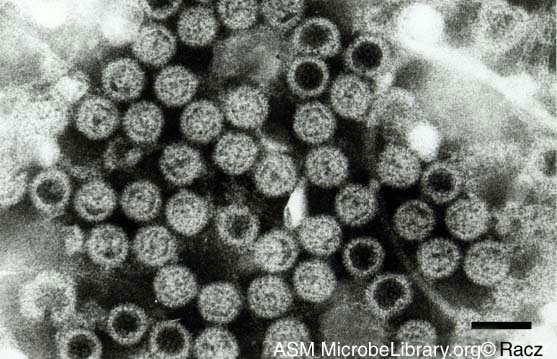Diarrheal Diseases
Types of Diarrhea
- Acute Diarrhea is the most common of the three and usually last for 1-2 days.
- Prolonged Diarrhea usually last for more than 2 days and is a more serious problem.
- Chronic Diarrhea is the most serious form of diarrhea and is usually the feature of a chronic disease.
 Rotavirus (viral infections) |  E. Coli (bacterial infections) |
Causes of Diarrhea
· Bacterial infections. Several types of bacteria consumed through contaminated food or water can cause diarrhea. Common culprits include Campylobacter, Salmonella, Shigella, and Escherichia coli (E. coli).
· Viral infections. Many viruses cause diarrhea, including rotavirus, Norwalk virus, cytomegalovirus, herpes simplex virus, and viral hepatitis.
· Food intolerances. Some people are unable to digest food components such as artificial sweeteners and lactose—the sugar found in milk.
· Parasites. Parasites can enter the body through food or water and settle in the digestive system. Parasites that cause diarrhea include Giardia lamblia, Entamoeba histolytica, and Cryptosporidium.
· Reaction to medicines. Antibiotics, blood pressure medications, cancer drugs, and antacids containing magnesium can all cause diarrhea.
· Intestinal diseases. Inflammatory bowel disease, colitis, Crohn’s disease, and celiac disease often lead to diarrhea.
· Functional bowel disorders. Diarrhea can be a symptom of irritable bowel syndrome.

Cryptosporidium (parasites)
Symptoms of Diarrhea
Diarrhea is often times associated with cramping, abdominal pain, bloating, nausea and or the urgent need to use the bathroom. In addition, depending on the cause of the diarrhea, a person may have a fever.
Treatment of Diarrhea
In the majority of diarrhea cases, the only treatment needed is re-hydration. This includes the replacement of lost fluids and electrolytes. In some cases, doctor prescribed antibiotics or medication may be necessary.
Key Points to Remember:
· Diarrhea is a common problem that usually resolves on its own.
· Diarrhea is dangerous if a person becomes dehydrated.
· Causes include viral, bacterial, parasitic infections, food intolerance, reactions to medicine, intestinal diseases, and functional bowel disorders.
· Treatment involves replacing lost fluid and electrolytes. Depending on the cause of the problem, a person might also need medication to stop the diarrhea or treat an infection.
Prevention
To help prevent future outbreaks of diarrheal diseases, two major changes must be made: surveillance and monitoring, and infrastructure and development. For surveillance and monitoring there needs to be a focus on climate-related surveillance, water quality monitoring, and diarrheal disease surveillance. With these surveillance tool put in place it will become much easier to track the direct effect that the climate has on our water quality and how that water can then lead to diarrheal diseases. As for the infrastructure and development, there needs to be effectively designed water and sanitation systems for all communities. Water and sanitation systems need to be strategically designed and placed to prevent and reduce contamination during climatologic events. While improving access to hardware (wells, latrines, and sewage systems) is essential, the long-term success of these improvements depends on infrastructure and program maintenance. With surveillance and infrastructure development put in place, there is greater hope in decreasing the amount of diarrheal disease cases in the future.
The Effect of Global Warming on Diarrheal Diseases
There are two main factors that link climate change to increases in diarrheal diseases. The first connection is in weather patterns and it consists of the fluctuations in the atmosphere, such as temperature, precipitation, and wind. For example, as the average sea temperatures start to rise, there will be an increase in the number of hurricanes, which will also be directly correlated to more flooding. Flooding is a big issue when it comes to diarrheal diseases because diarrhea is mostly caused by waterborne illnesses. Vibrio species organisms, including v. cholerae, thrive in particular sea conditions containing warm water, moderate salinity, and number of aquatic invertebrates. All of these conditions are influenced by climate change. The second main connection between climate change and diarrheal diseases is focused on the rising air temperatures. Rising air temperature poses a huge threat because it allows certain bacteria, viruses, or parasites to live longer and to live in certain areas where they normally cannot. Many causative agents of diarrheal disease have a seasonal variability, with peaks in the warmer months. Increased temperatures or higher temperatures for longer times can result in higher than
Sources for Diarrheal diseases page:
http://digestive.niddk.nih.gov/ddiseases/pubs/diarrhea/index.htm
http://www.oneworldhealth.org/diseases/diarrhea.php
http://www.prb.org/Articles/2007/ClimateChangeinLatinAmerica.aspx
http://www.prb.org/Articles/2007/ClimateChangeinLatinAmerica.aspx
http://www.ehponline.org/members/2001/109p155-159singh/singh-full.html
http://www.universityofcalifornia.edu/everyday/agriculture/ecoli.html
http://web.centre.edu/bio/richey/bio340.htm